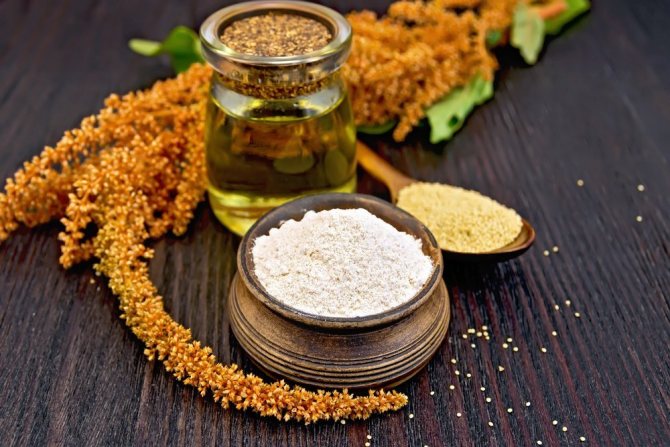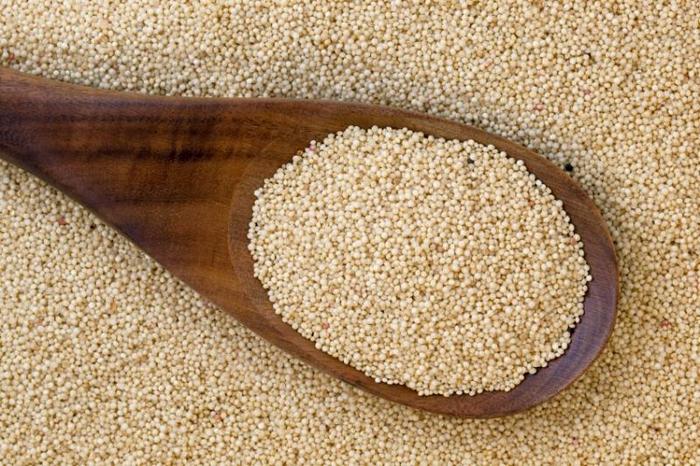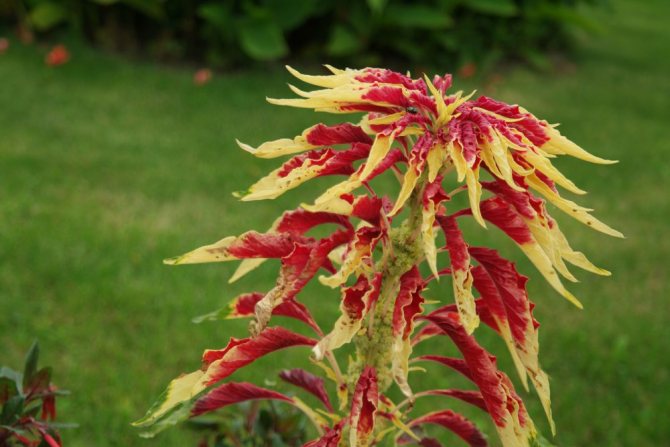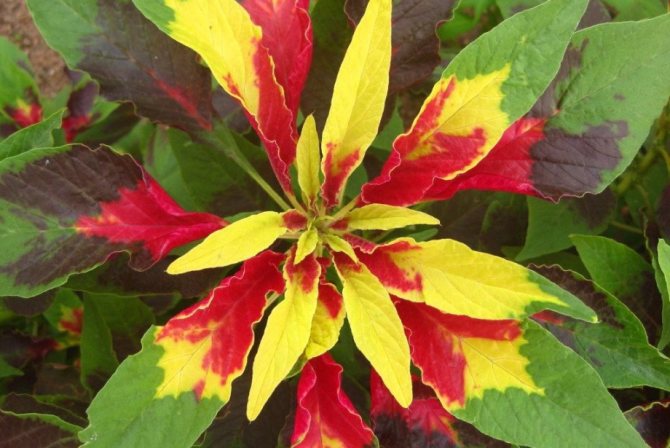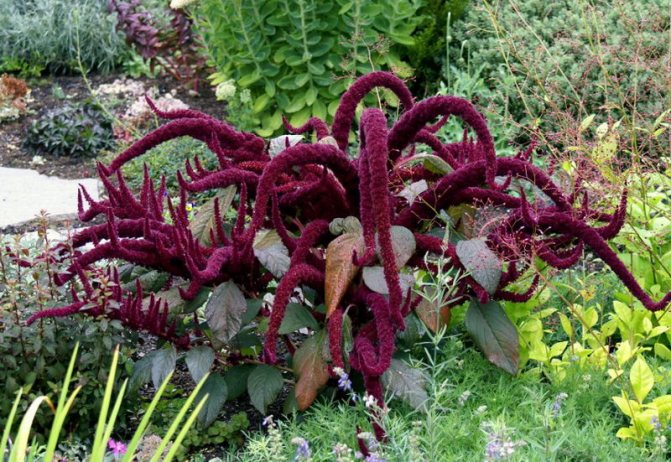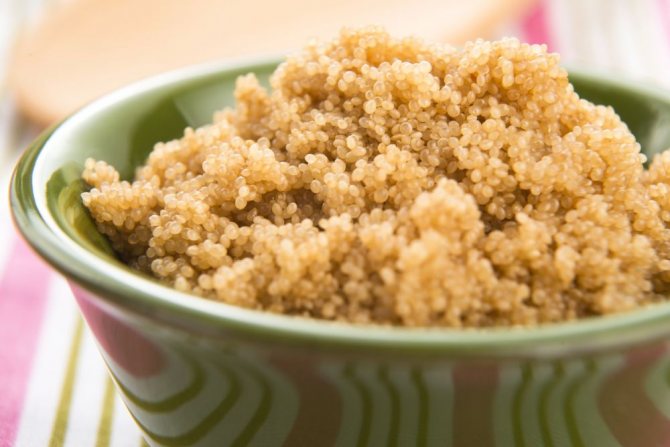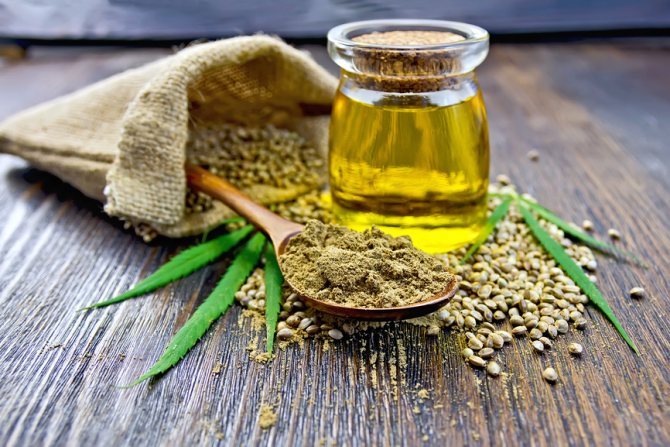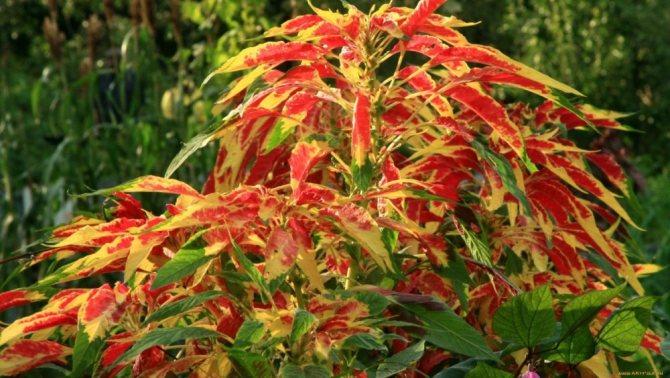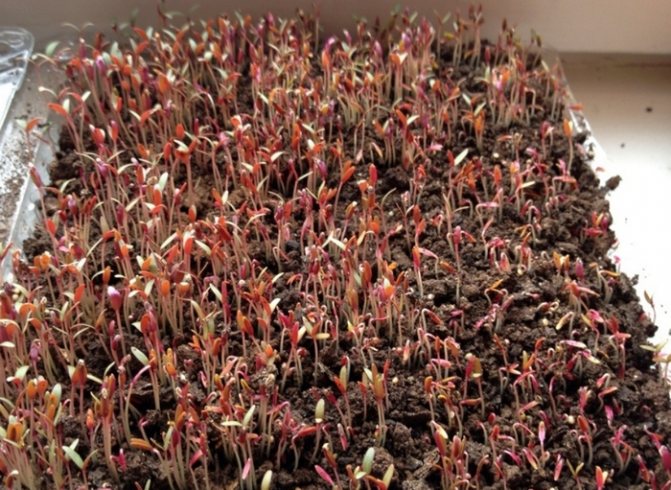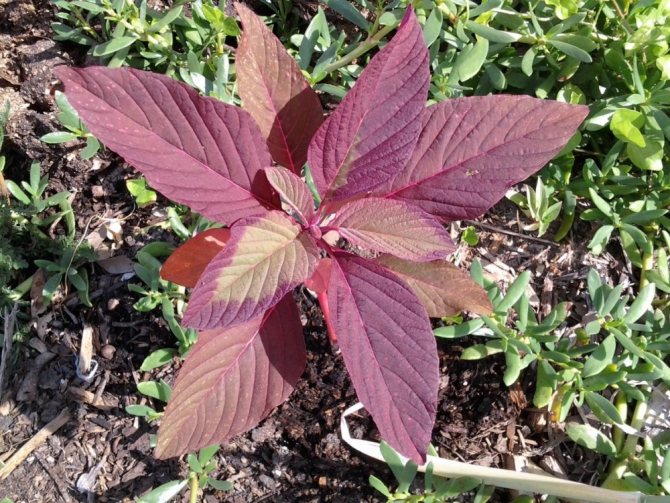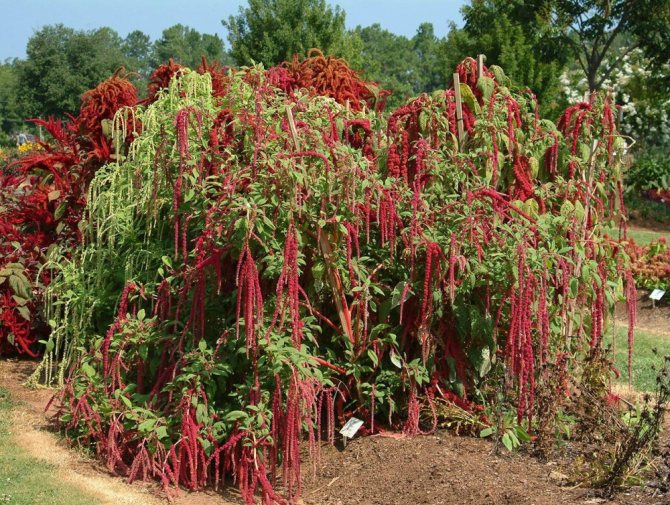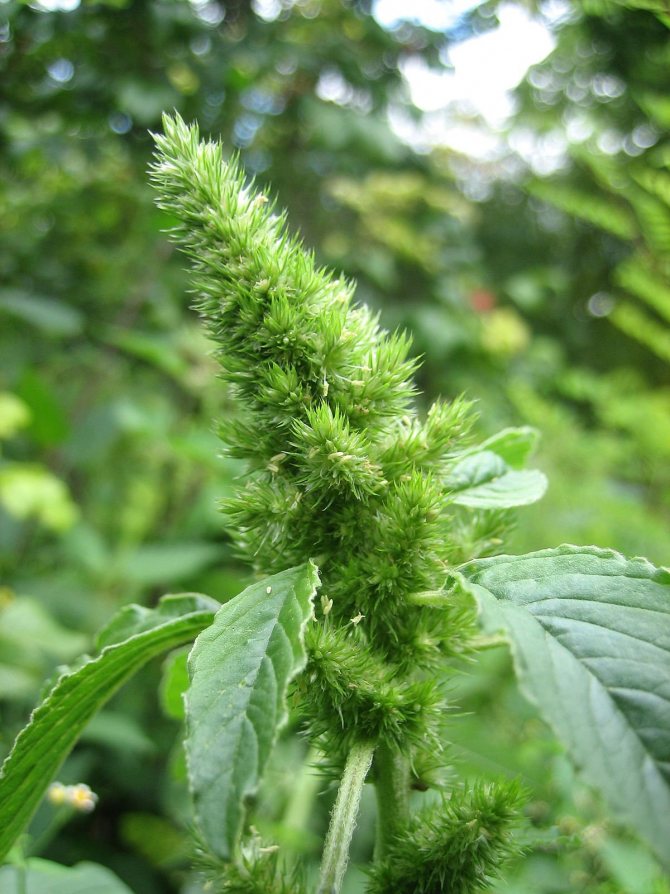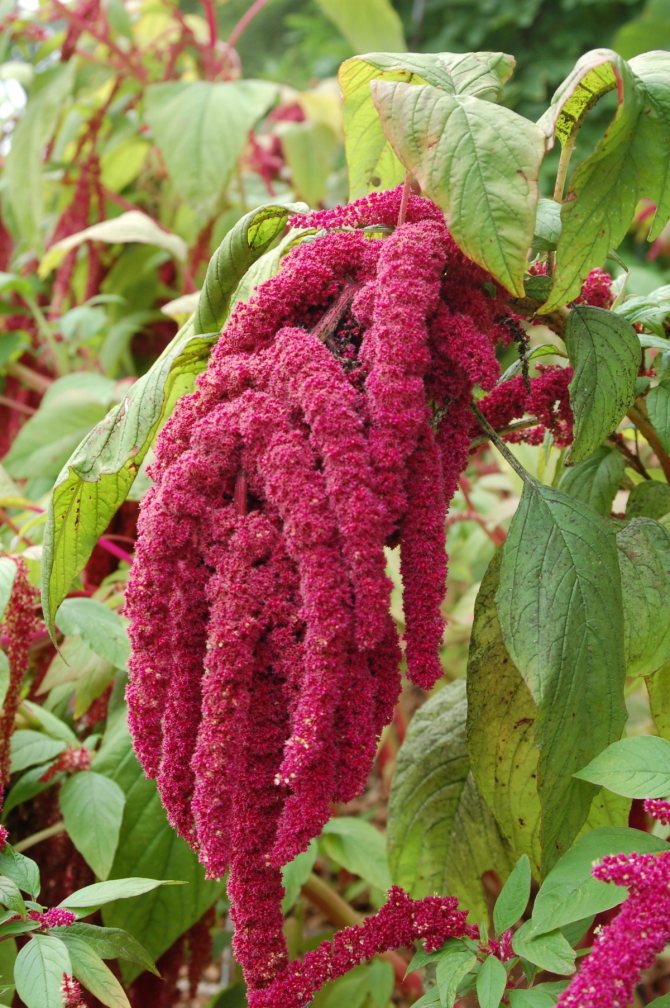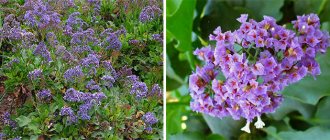Since ancient times, the plant called "amaranth" was cultivated by the Aztecs and Incas for rituals with sacrifice. The Spaniards, the conquistadors, who arrived to conquer the New World, decided to suppress the pagan rites. Calling the amaranth flower "the devil's plant", they destroyed the ancient culture everywhere. Let's talk in more detail about this wondrous plant, which the Spanish warriors could not eradicate.
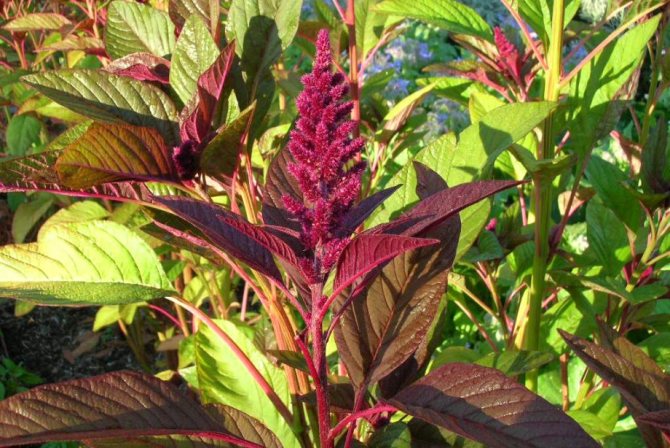
Amaranth photo
Description and properties of the Amaranth plant
Amaranth is also called a shiritsa and belongs to the Amaranth family. In Mexico and South America, it was this plant that became the main one used in nutrition in ancient times by indigenous peoples. Now some varieties of amaranth are already considered weeds. This culture came to Europe from the Spaniards, who brought amaranth as an element of decorating flower beds. Later, the plant began to be used as food and grain.
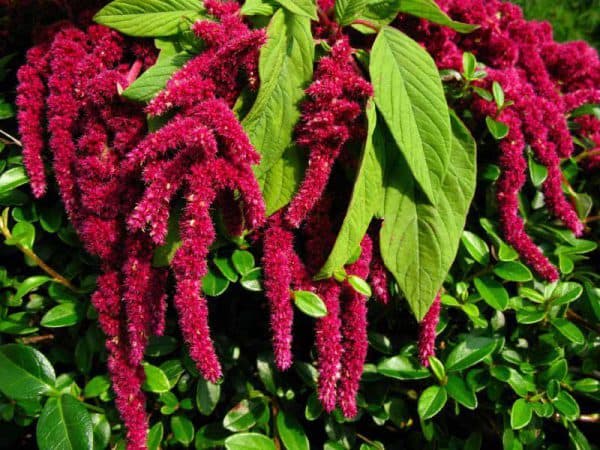

Amaranth plant
Amaranth can grow on branched or porous stems. The leaves are always whole and alternate, can be diamond-shaped, ovate or lanceolate. They stretch out at the base, the top of the leaf has a small sharpening and a slight notch. Axillary flowers are found in various tones: golden, green, purple, red. Blossoms are always collected in bunches, and at the very top are represented by spike-shaped panicles.
After flowering, it forms a fruit in the form of a capsule, where rather small seeds are found. The whole plant also has a variety of shades of purple, green or purple, and some varieties combine all of these tones. The variety also affects the height of the amaranth, and can range from 30 centimeters to 3 meters. It is grown more often as an annual plant. Due to its decorative and unpretentious nature, the flower is often used for arranging flower beds and flower beds. For more details on the formation of a flower garden in the country, see here.
In our open spaces, amaranth has many alternative names: cat's tail, squid, cockscomb, velvet, axamitnik. However, the name amaranth has Greek roots and is translated as an unfading flower.
How to use amaranth meal?
Amaranth meal - trimmings after pressing the oil from the "cock's combs". Do not take them as unnecessary leftovers. Amaranth meal is unique for its ability to burn fats and remove toxins from the body.
The product contains enough protein, so it is recommended for athletes and children with physical development retardation. The benefits and harms of amaranth meal are very conditional. It all depends on the personal tolerance of the product. It is allowed for pregnant women and breastfeeding women because it helps relieve constipation and improves lactation.
Reception of meal - 1 tsp. in the morning and in the evening. It is consumed as a food supplement for 3 weeks. At the end of this period, a break is made for a period that will be indicated by the attending physician after studying the test results.
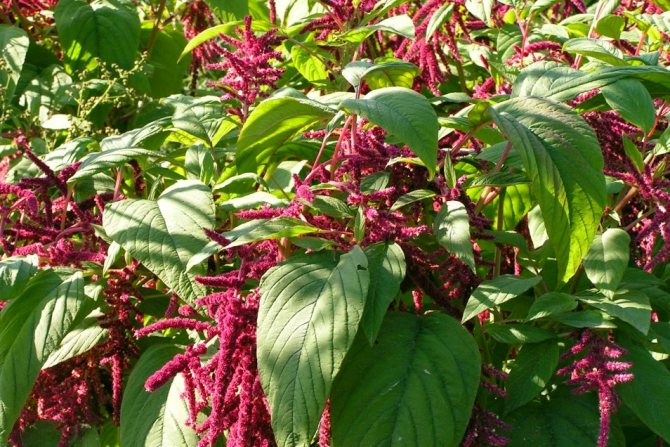

There is a lot of protein in amaranth meal
Species and variety
Since the culture quickly found application in all industries, a lot of varieties were bred. Basically, the varieties are divided into 4 types: food, grain, fodder and decorative.And the qualities of each species were derived accordingly: in food - on the taste of the whole plant, in cereals - on the number of seeds and their taste, in fodder - on the nutritional value and size of the plant, in decorative ones - on a bright and unusual appearance.
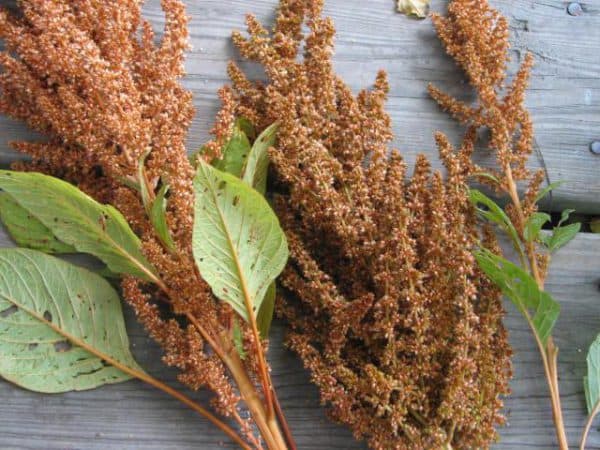

Food grade
Food amaranth is distinguished by a high content of various useful nutrients and a rather high protein content in stems and leaves. Reproduction occurs, like all Amaranths, by seeds. Despite the selection of nutritional qualities, the plant is most often used for decorative purposes. These varieties are also characterized by the fact that absolutely all parts of the plant are edible in it: stems, leaves, seeds.
The most famous edible varieties:
- Valentine;
- Sturdy;
- In memory of Kovas;
- Ororeo or Opopeo;
- White amaranth (White Leaf).
Amaranth seeds are incredibly useful and can be used to make oils, as food, and to feed pets. Cereal species are characterized by a large amount of seed yield, and the leaves and stems are considered inedible. The most famous grain varieties:
- Helios;
- Kharkov-1;
- Voronezh;
- Ultra;
- Orange giant.


Orange giant
Most farmers have appreciated the benefits of growing amaranth forage varieties. These varieties are most often very tall, have succulent leaves and stems, grow quickly and give large yields. They are like feeding almost all animals: cows, pigs, chickens, rabbits. All parts of amaranth, including the root system, can be eaten.
For sowing fodder amaranth, the following varieties are suitable:
- Giant;
- Aztec;
- Lera;
- Kizlyarets;
- Royal;
- Emperor.
Ornamental varieties vary in color of leaves and beauty of flowering. Flowers can be not only bright, but have radically different shapes. Decorative amaranth will delight you with its appearance both during the dry season and until the very frost. A lot of time was allotted to the cultivation of ornamental varieties. Only the most famous varieties:
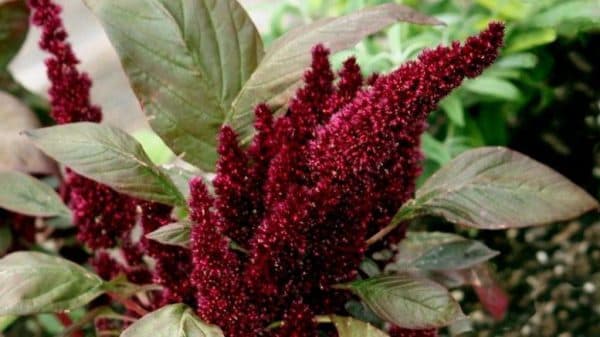

Dark amaranth
- Dark Amaranth;
- Tailed Amaranth;
- Red or paniculate amaranth;
- Tricolor Amaranth;
- Green Amaranth;
- Rother Dam;
- Yellow Amaranth;
- Hot Biscuit;
- Rotschwanz;
- Pygmy Torch.
All decorative amaranths are incredibly beautiful, so they are often used not only to decorate a flower bed or a personal plot, but also in making bouquets, flower arrangements, and wreaths. They retain their freshness for a very long time after cutting, and when growing in the ground, they are very resistant to weather conditions.
The controversial issue of grass
There is a controversy around the beautiful plant: are amaranth and amaranth twins? Most experts are inclined to believe that these concepts are identical. Others believe that the amaranth simply looks like an amaranth. They argue their conclusions by some divergence of plant characteristics. Schiritsa is considered a weed, amaranth is a cultivated herb. However, skeptics do not deny that these are representatives of the same family.


Common schiritsa
When choosing a crop variety, one should consider for what purposes it will be grown: for decoration, treatment or eating. In any case, amaranth is a plant that will definitely be useful for connoisseurs of beauty, gourmets and livestock breeders.
Features of growing from seeds
Amaranth can be grown both in a pot to get seedlings, and immediately in open ground. For growing in pots, the best time is March. From the container, you can take ordinary flower pots or peat pots, and a suitable height is 10 centimeters. The seeds do not sink very deeply, 1.5-2 centimeters are enough and this greatly facilitates watering: the soil can simply be sprayed from a sprayer.


Seeds
The germination rate depends on temperature and light conditions. At a temperature of 22ºC, the first shoots will appear on the 4th-5th day, and at 16 ºC - on the 10th day.To stimulate a set of green mass, seedlings can be treated with a urea solution.
Since the germination of Amaranth seeds is very high, the sprouts will need to be thinned out as soon as they have three full-fledged leaves, and then transplanted into separate slightly deeper pots.
Sowing in open ground
Amaranth germinates very well when sown directly into the ground. It is important to wait for the time when at a depth of 4-5 centimeters the soil warms up by about 10ºC under the sun. Until this time, it is advisable to fertilize the soil on the site. Mineral mixtures and complex fertilizers are suitable. Mineral fertilizers will need 30 grams per square meter for digging, and complex fertilizers are mixed, as indicated in the instructions. For more information on the types and applications of mineral dressings, see here. When choosing a fertilizer, try to find formulations with the lowest nitrogen content, since amaranth "knows" how to process nitrogen fertilizers into nitrates.
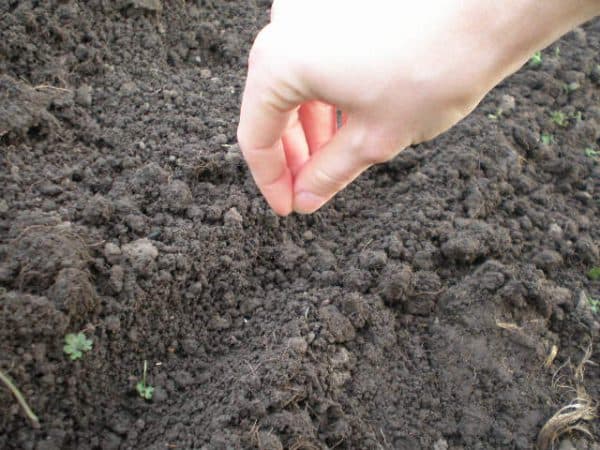

Soil preparation
Sowing in the soil of this temperature, usually the end of April, gives amaranth rapid growth without the risk of being "suppressed" by weeds. Sowing in May will also give good shoots, but you will have to constantly weed amaranth from weeds. Sowing is done in grooves with damp soil. You can spread each seed 1.5-2 centimeters into the ground, or you can mix the seeds with sawdust or sand in proportions of 1:20. The grooves should be 45 centimeters apart, and 7-10 between the seeds. The first shoots will be a little more than a week later, and all frequent shoots should be thinned out. Be sure to loosen the soil until the amaranth "comes into force."
When the plant becomes 20 centimeters, you can “feed” the amaranth a little more. Fertilization with nitrate is now fine, but halve the concentration as recommended by the manufacturer.
Planting seedlings
Planting of seedlings occurs when the night frosts have definitely ended. Most often this is mid to late May. The best soil is nutritious and light, with limestone impurities, and the site is lighted and drained.
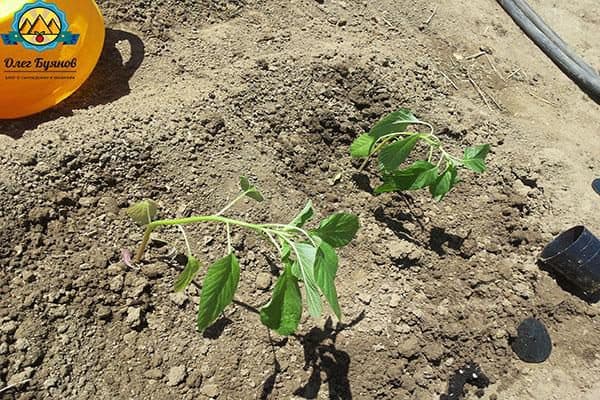

Planting seedlings
Amaranth is not capricious, but he does not like the cold and a large amount of moisture in the ground. Before planting amaranth seedlings, dig up an area with 20 grams of nitroammophoska per square meter. Read more about the properties and rates of fertilizing nitroammofosk here.
The location between the seedlings is determined by the amaranth variety and can range from 10 centimeters to 30 centimeters, and the rows can be located from 45 centimeters to 70 among themselves. Until the seedlings are definitely taken in and do not go into active growth, they will have to be watered regularly, but without fanaticism, since the plant still does not like moisture. If cold weather suddenly comes, then the amaranth will have to be covered so that it does not get sick or die.
Sowing, collection and storage
The amaranth sowing technology implies a seedling and non-seedling method. In the first case, planting is carried out in March - April (in the box) and in May - June (in the garden). In the second variant of sowing, the seeds are placed in the ground when there is no danger of frost.
All varieties require care within the first month, unless we are talking about wild-growing amaranth. Cockscomb greens are harvested when they are 25 cm tall. Don't worry about haste, as new shoots will soon grow from the cut tops.
The seeds are harvested in September until the grain panicles begin to turn brown. The resulting crop is dried in a dark place. Leaves are harvested before they fall (late August - early September). It is during this period that they are suitable for making medicinal drinks.


Amaranth is sown in a seedling and non-seedling way.
Collecting seeds after flowering
Seeds for future planting are very easy to collect. Amaranth seeds will retain their germination for another 5 years.Storing them is also easy - a paper bag or box will do.
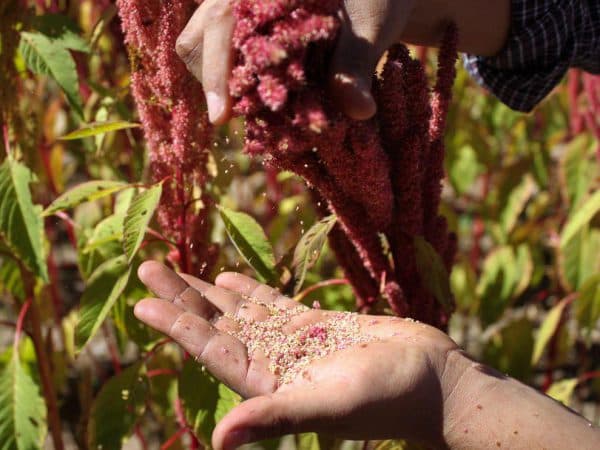

Seed collection
- Choose one or more of the "strongest" amaranths and do not tear off the leaves from them.
- Wait until the lower leaves turn red, dry on their own and the amaranth will throw them off. By this time, the stem of the plant will become almost white.
- Now you need calm and dry weather to cut off all the inflorescences on amaranth. Better to start from the very bottom.
- After collecting the inflorescences, they should be dried. Drying is best done in a well ventilated and dry area. The "panicles" will dry for several weeks.
- As soon as the inflorescences are well dry, you can start collecting seeds. You will have to do this manually, rubbing each "broom" with your fingers. Small seeds will fall out of the "boxes" very easily.
- At the end, be sure to sift the amaranth seeds through a sieve.
If you have planted several varieties, then dry them in different places so that the seeds do not mix. The rest of the amaranth can also be used. The leftover stem can be folded into a compost pit for a terrific fertilizer for the future.
Recipes
The herb will help with the following pathologies:
- Dermatitis. 350 g of raw materials are steamed in 2 liters of boiling water. The water bath is kept for 15 minutes. The healing liquid is added to the bathroom, which is taken in the morning and evening.
- Gastritis. With painful stomach cramps, a miracle porridge is prepared: a glass of seeds is boiled in 0.5 liters of water for 45 minutes. Nuts and fruits are added to porridge during remission of the disease.
- Cystitis. 3 tbsp. l. chopped grass and inflorescences are poured into 1 liter of hot water. 200 ml of the drink at night is enough for a week.
- Chronic fatigue syndrome. 2 tbsp. l. chamomile, birch buds, St. John's wort and amaranth seeds are infused for 2 hours in 0.5 liters of boiling water. The drug is drunk in a glass in the morning and before bedtime.
- Painful menstruation. 1 tbsp. l. grass leaves are poured with 200 ml of hot water and the healing drink is kept for an hour. Drink the liquid in small sips until the spasms stop.
- Enuresis. You will need fresh inflorescences with seeds that need to be chopped. They are steamed in a glass of boiling water and used twice a day for 1 tsp.
- Cervical erosion. To make tampons, use cotton wool soaked in 2 tbsp. l. velvet oil. Home therapy is carried out at night for a week.
Fertilizers and care
Amaranth is completely undemanding to care. The most difficult period for this plant is until the moment of active growth. Usually, amaranth needs almost a month to harden well, and during this time it grows very slowly. In the first month, you will have to weed the beds, regularly water the amaranth and loosen the soil near the seedlings.
Feeding is often unnecessary. Enough 3-4 times for the whole season. The best feeding is mullein solution and wood ash. The solution is diluted in proportions 1: 5, and ash will need 200 grams per 10 liters of water. The best time of day for fertilization is early in the morning after watering the entire area.
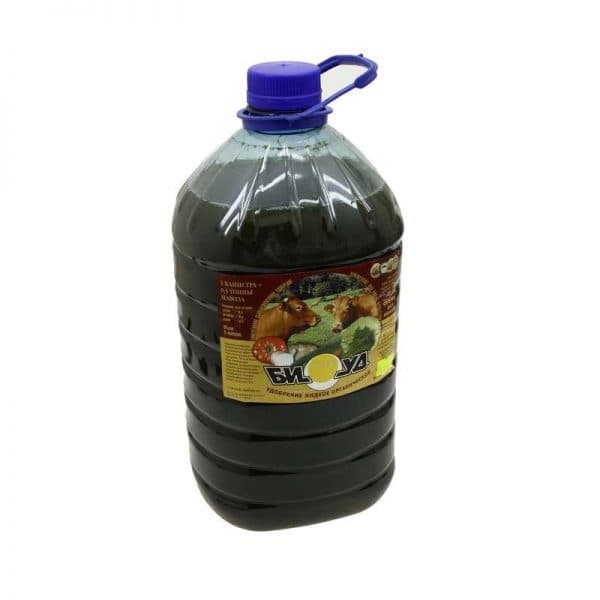

Mullein
You will notice the period of active growth immediately. Some varieties can grow by 5-7 centimeters only in a day. After that, there is no need to often water the amaranth - its root goes very deep. However, if a very dry period has fallen, then watering will still be needed. Just make sure that the ground is not too dry or constantly wet.
Growing seedlings


Photo: <>
A few tips for growing seedlings from amaranth seeds will help you plant this plant correctly and get a healthy, rich harvest in the future.
Sowing time
Many beginners are interested in the question of when to plant amaranth seeds in order to quickly get a harvest. Since amaranth ripens for a long time, experienced gardeners begin to prepare seeds from the first decade of February.


Photo: <>
Grains are suitable for sowing since the second February decade. But in this case, it will be important to use artificial lighting to compensate the seeds in winter for the missing rays of the sun.In central Russia, the Moscow region and the Urals, experts recommend sowing amaranth from mid-March.
Soil preparation
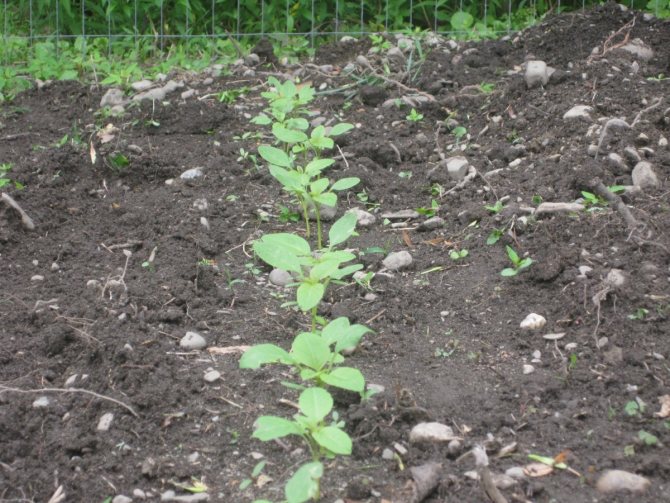

Photo:
A universal primer, which can be purchased at any flower shop, is ideal for shiritsa. For those who want to independently prepare the soil, we will inform you that the land for amaranth should consist of garden soil, humus and peat. The soil should be nutritious, loose, with good air permeability. It is recommended to disinfect the soil before planting seedlings.


Photo:
It can be ignited, frozen or treated with a manganese solution. Copper sulfate, colloidal sulfur, "Fitosporin" can be good means for cleaning the earth.
Lighting
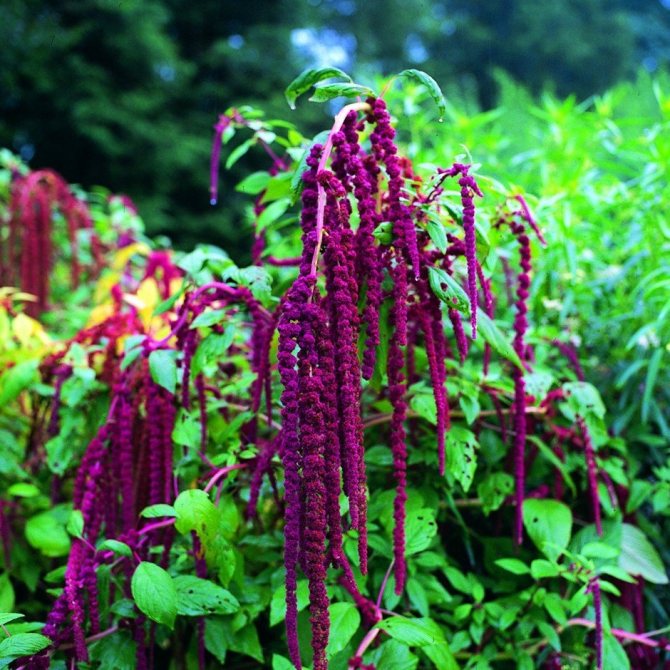

Photo: <>
Good lighting improves the chances of a rich harvest. It is best to grow seedlings in an equipped greenhouse with electricity. In the northern regions, with a lack of lighting, amaranths are reluctant to enter the flowering stage, but they grow strongly and form more leaves than those plants that are grown in southern latitudes.
Watering and feeding


Photo: <>
At the time of sowing seeds for seedlings, the soil must be moistened. Potted seedlings should be kept in moist soil at all times. In hot regions, it is recommended to water the plants before sowing. Watering amaranth during the growing period is possible only on dry days; if you do this more often, then you can fill the plant. When the seedlings reach 15-20 cm in height, you can feed the roots with nitroammophos or a complex of mineral fertilizers.
Pick order
Seedlings dive at the formation of one leaf on each sprout. It is advisable to dive the sprouts into small pots 5x5 cm.
Diseases and pests
Amaranth is also distinguished by excellent "health". It is practically not attacked by pests and almost does not "get sick". Only weevils and aphids can harm the plant. The last pests pose a strong threat only in the first month of amaranth growth, but weevils develop in the amaranth stem and can greatly delay its development.


Aphid
Aphid attack can be expected if the summer is too wet, but everything is solved by processing with special means. Both aphids and weevils die after processing the plant with karbofos (fufanon) or actellik. Strong moisture can also provoke fungal diseases. But they are also very easily treated by spraying. Copper oxychloride, colloidal sulfur, copper sulfate and other fungicides are suitable.
For what diseases amaranth is used
The amaranth plant has long and very successfully been used in folk medicine for the treatment of diseases such as diabetes, neurosis, obesity, vitamin deficiency, as well as for various disorders of kidney function. Amaranth is very useful for strengthening and restoring health in people during the periods after various operations.
Amaranth is successfully used to treat various inflammatory processes of the genitourinary system in men and women, with hemorrhoids. Amaranth oil perfectly helps with anemia, severe loss of strength, skin diseases, gastric and duodenal ulcers, burns, stomatitis and even atherosclerosis.
Today, a large number of medicines are produced containing amaranth oil, which help to reduce the level of bad cholesterol in the blood, help the body with radiation exposure, and stimulate the resorption of malignant tumors.
Areas of application of amaranth
Amaranth looks spectacular alone, in a group with other plants, along garden paths and in hanging pots.
Since different parts of amaranth are edible, there is a demand for it in the culinary field. So, bakery products are baked from amaranth flour, pasta, breakfast cereals and baby food are made. The seeds are used to make cereals (quinoa), from which nutritious and healthy cereals are obtained.Vegetable varieties are used for the preparation of salads and soups. And also greens are added to meat and fish dishes, sauces.
What is the value of amaranth
Chemical studies have shown that tailed amaranth and other members of the family contain a large amount of vitamins in flowers, leaves and stems:
- group B (thiamine, riboflavin, choline, niacin, folic and pantothenic acids);
- group E;
- vitamins of groups C and P;
- beta carotene.
Plants contain polyunsaturated fatty acids, including linolenic, stearic, palmitic and oleic. Seeds contain the most of them. The amino acid lysine is found in vegetable protein, which is rich in amaranth.
Speaking about proteins, we note the saturation of plants of this family with tryptophan and methionine, valuable in terms of energy.
We list the abundance of trace elements that make up amaranth: magnesium, sodium, calcium, fluorine, potassium, selenium, zinc, iron and manganese.
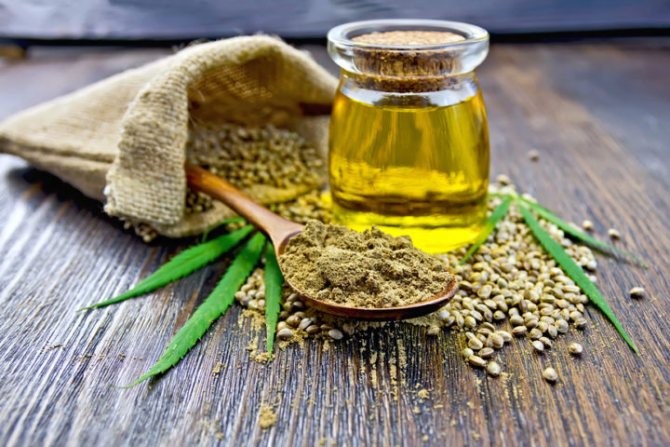

Amaranth has a wide range of trace elements and vitamins
Due to this saturation, derivatives from leaves, flowers and fruits have the following medicinal properties:
- antibacterial and anti-inflammatory;
- diuretic;
- hematopoietic;
- anti-sclerotic.
As a powerful antioxidant, the plant is used as a means of preventing tumors, used to treat the effects of radiation. And amaranth also helps to increase immunity, accelerates the healing process and stops bleeding.
If we take the total volume of the substance, then out of 100% - 18% will be for vegetable sugar and protein, and 14% for fiber.
How and when to plant
And although amaranth has many advantages, it also has its disadvantages, including long germination. If you are planting amaranth to obtain oil, then you should decide in advance on the timing of sowing. At the same time, keep in mind that the plant has enough light and heat.
In the Russian climate, where the summer is short, planting seeds should be done in the first half of February. Sowing this early will require auxiliary lighting and temperature monitoring.
For the full development of young seedlings, it is necessary to provide a temperature regime of 22-25 degrees in the room.
The substrate for amaranth can be used universal. It has yet to be prepared in the fall. The soil mixture should be loose, perfectly retain moisture and contain all the necessary trace elements.
If you have to grow seedlings, then it is worth using a substrate consisting of sod land, peat and humus. Take everything in equal quantity. Saturate the soil in advance with mineral, potash fertilizers. You can also add nitrogen, wood ash. In addition, the soil should be disinfected. To do this, pour it with boiling water or a solution of potassium permanganate. This will eliminate pathogens.
It will also be interesting to know how the cultivation of the seeds of Ursinia Ondine takes place:
Sowing seeds
On the video - growing Amaranth:
For small seedlings, moderate watering is necessary, but without stagnant water. If the seedlings are planted tightly, then they should be thinned out. Perform a pick 2-3 times so that the culture has a powerful root system.
During the picking, deepen the sprout to the first leaves. Seedling care also involves the use of fertilizers. For this, complex feeding is suitable, for example, Kemira. You need to bring it in as soon as real leaves are formed. The second time feeding will be necessary in a couple of weeks.
Landing in open ground
To grow a full-fledged plant, it is necessary to create full-fledged conditions for it. When choosing a site, make sure that there is fertile land and good illumination on it.
In the fall, fertilize the soil with humus with the addition of potash-phosphorus fertilizers. This should be done not in spring, but in autumn. Dig the site thoroughly. Plant the grown seedlings in holes that are located at a distance of 30 cm.Such events should be carried out at the end of May, when the soil is thoroughly warmed up and there is no frost.
Open ground transplant principles
When transplanting plants into a garden plot, it is important to consider several recommendations. They relate to the choice of time and place where the flowers will be planted.
Amaranth seedlings are ready for planting in open ground
Seedling boxes prices
seedling boxes
Principle 1. Amaranths grow in the sun
A place for amaranths is chosen in advance. In general, this plant is able to take root in any conditions. However, there are a few things to consider:
- The plant needs a lot of light... Choose the sunniest and warmest place on the site. There, amaranth will develop actively, and the flowers will be much brighter than in the shade.
- Excessively wet and swampy soil is not suitable for growing amaranth... This plant loves sandy loam or loamy soil and good drainage.
- Amaranth is a very friendly culture, which gets along well with other flowers.
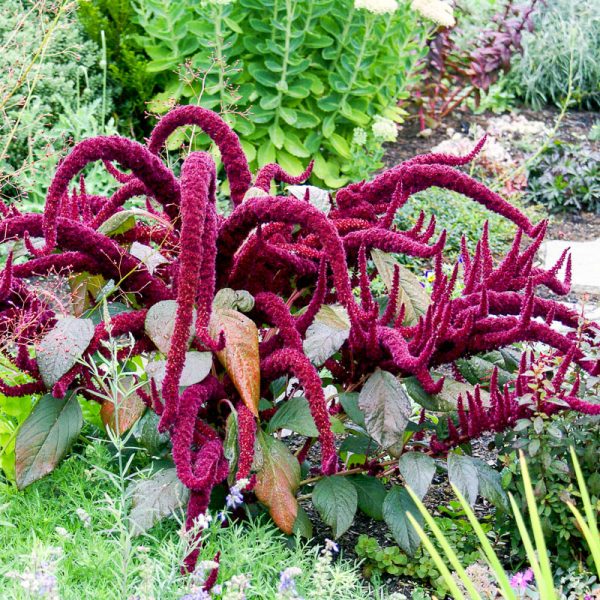

In the sun, the flower actively grows into a beautiful bush.
Principle 2. Flowers are transplanted in the evening
The best option for transplanting seedlings is late evening or cloudy weather. There should be no sun on the site. Transferring from pots is already stressful for young plants, and bright sunlight can completely destroy them.
The same principle applies for the next 3-4 days after the transplant. If the weather outside is sunny, it is recommended to shade the plants for a few days. In such conditions, they adapt better to a new place and begin to grow more actively.


Open ground transplant
Principle 3. Good watering and neatness
So, the place and time have been chosen, the seedlings are ready. The disembarkation process begins:
- The soil in the pot with seedlings must be well moistened so that they come out of the soil more easily.
- In the prepared soil, it is necessary to make holes sufficient to accommodate the rhizome. The distance between the bushes should be about 30-40 cm.If a whole flower garden is planned, the gap from row to row should be at least 70-80 cm.
- Young seedlings should be removed from the pots as carefully as possible so as not to damage the roots. Plants are placed in the holes at a slight slope.
- The seedlings are deepened in the ground to the first leaf, and the soil around it is slightly crushed.
Rows of amaranths in the ground must be watered well. This will allow the plant to adapt more quickly to the new soil.


Growing amaranth in open ground
How to care for seedlings
Amaranth seedlings are taken care of in the same way as other garden crops. Care consists of several points, all of them are presented in the table below.
Table 2. Principles of caring for amaranth seedlings.
| What do we have to do? | Features of the |
| To water | The soil under the sprouts should always be moist, but not too damp. It is best to moisten the soil with a spray bottle as it dries, so as not to accidentally damage the young sprout with a dense stream of water from a watering can. |
| Highlight | In late February and early spring, seedlings do not have enough sunlight, and amaranths need full daylight hours. For plants to develop correctly, they need to be highlighted. Fluorescent lamps or special phytolamps are ideal for these purposes. |
| Harden | The first hardening procedure is carried out 10-12 days before planting the seedlings on the garden plot. For this, the plants are taken out on the balcony or outside for 15 minutes a day. The hardening time increases gradually. If it is not possible to take the pots outside, you can simply open the window. |
| Dive | Saplings dive after the appearance of 3-4 true leaves. The strongest plants are transplanted into individual pots with a diameter of at least 10 cm. |
Recommendations for picking will be as follows:
- The cups are filled with earth to the very top. It is best to take the land from the common box where the seedlings grew.
- The earth must be moistened in advance.A 3-4 cm depression is made in each glass.
- The seedlings are carefully removed from the box one by one and placed in a glass.
- After transplanting, the tops of the seedlings are pinched. This will cause the plants to develop roots rather than pull upward.
Description
Amaranth (Amaranthus) is a representative of the Amaranth family. The amaranth bush is green, purple or violet in color, and more often combined. It is formed from smooth or branched stems, the thickness of which reaches 7-19 cm. The shape of the leaves is lanceolate, oval or diamond-shaped with the base of the leaf extended into a petiole. The apex of the leaf has a sharpened groove. The arrangement of the leaves is alternate. The height of the plant depends on the variety and ranges from 30 cm to 3 m.
Inflorescences-bunches of small flowers are located in the axils of the leaves. Apical inflorescences are spike-shaped panicles. They are painted green, crimson, purple or golden. Amaranth is a wind-pollinated plant. The achene resembles a box. Small seeds are found in brown, white and black colors.
In temperate climates, amaranth is an annual. The plant is divided into fodder, vegetable, decorative and grain types.


Appearance
Adult life: transplanting amaranth into open ground
If the sowing took place in mid-March, the seedlings will be ready for transfer to the garden plot already at the beginning of May. As a rule, at this time the soil is already warming up to +4 ... + 6 ° C, and the danger of night frosts disappears.
But the young growth all this time lived in a greenhouse climate, so before transplanting it needs to be prepared.
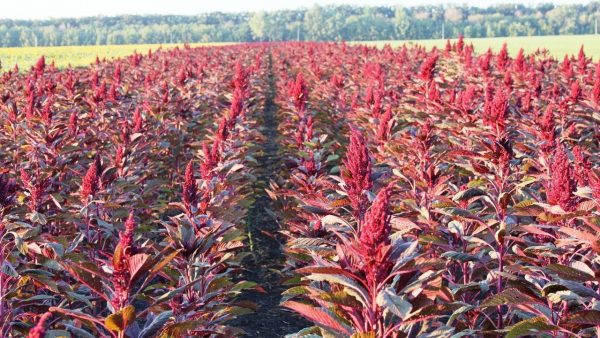

Decorative flower garden of bright red amaranth
Preparing seedlings for transfer to the ground
Young greens must go through several procedures. They will help you get used to the garden climate. These are:
- Decrease watering... Reduce the frequency of watering a week before the expected transfer to the ground.
- Long-term hardening. Pots with seedlings are taken outside for 2-3 hours. The last 3-4 days before transferring to the ground, the plants are left to spend the night in outdoor conditions.
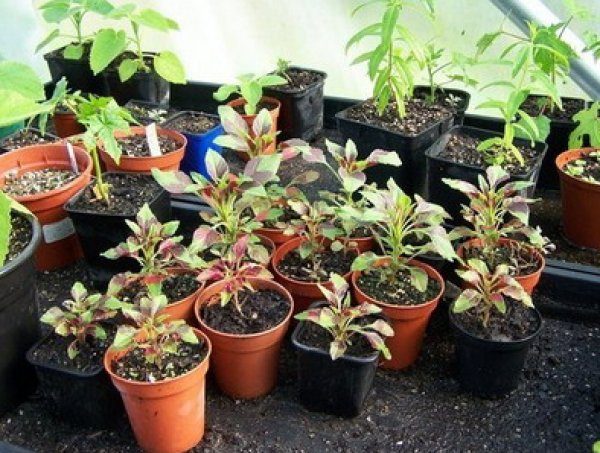

In the third decade of May, it is time to plant young amaranths in the open land
Both beautiful and useful
Unpretentiousness and the ability to grow in any conditions, to give beautiful flowers - this is what quickly made the plant popular. Summer residents and flower growers in our middle latitudes use four types:
- tailed amaranth (Amaranthuscaudatus);
- panicle amaranth (Amaranthuscruentus);
- sad amaranth (Amaranthushypochondriacus);
- tricolor (Amaranthustricolor).
The last variety fell in love with gardeners for its beautiful appearance. The amaranth tricolor flower literally amazes with its amazing transitions from rich red to yellow and green.
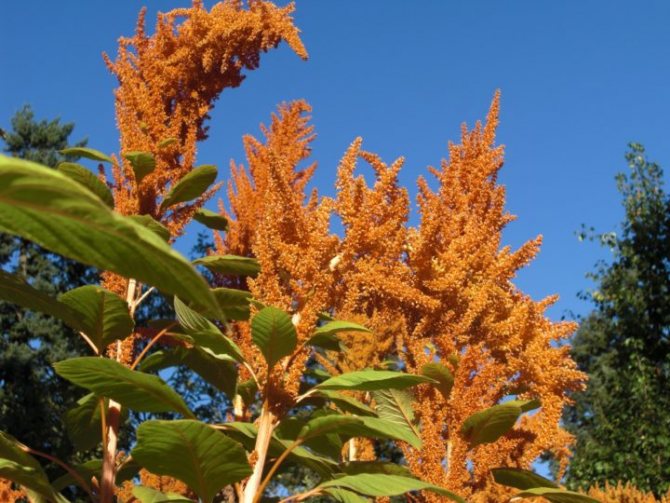

Amaranth flower can have different colors.
Tailed amaranth looks no less interesting. Its flowers in the form of long lashes can grow up to 0.8 m (with a total stem height of up to 1.5 m). Petals, covering a gamut from red-burgundy to orange and yellow-green, adorn flower beds in different regions of our country.
Given the specifics of flower formation, tailed amaranth is planted in rows, sometimes used as a decorative hedge. Dense groups of plants in flower beds look no less beautiful. Then, during flowering, a waterfall of an unusual appearance and color is formed.
The properties described above to be well preserved are successfully used by florists to draw up winter bouquets, housewives decorate their homes with dried amaranth flowers.
Let's move on from the beautiful to the useful. From the composition of amaranth, chemists have isolated such substances important for human life:
- amarantine;
- rutin;
- squalene.
In addition, plants of the amaranth family contain carotenoids, which give plants and fruits their characteristic color. These substances play the role of antioxidants and play an important role in the metabolism in the human body.
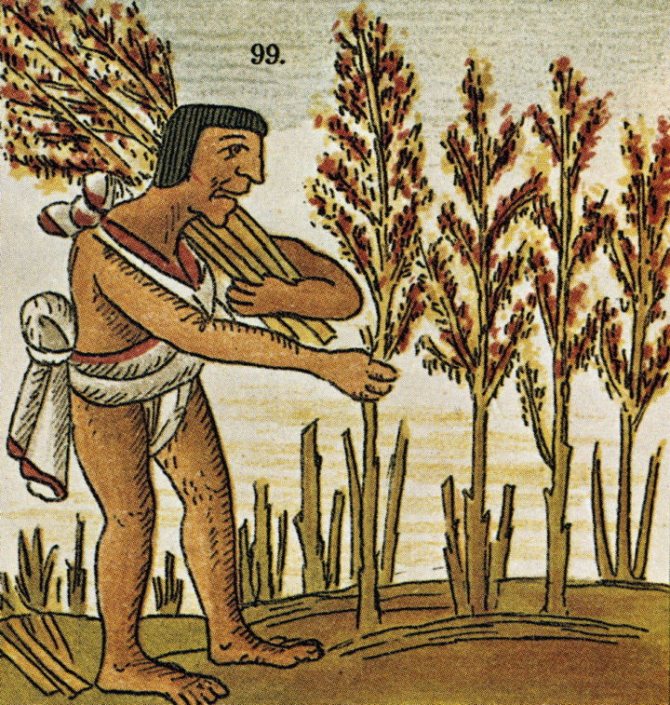

The beneficial properties of amaranth leaves and flowers have long been known to people.
The beneficial properties of the leaves and flowers of this representative of the plant world have long been known to people and deserve a separate detailed presentation. Summer residents harvest amaranths for the winter, preparing various drugs and medicinal compositions from them.
Purchase of amaranth seeds
Those who have never cultivated amaranth before can purchase the seeds of this plant in the store. But everything is not so simple here. Unscrupulous growers may sell the wrong variety that is required. Amaranth is a cross-pollinated plant. Some varieties of amaranth can be pollinated with others and give an unpredictable result. The seeds must be of good quality, otherwise you can grow a plant that is neither good for food nor for decoration. That is why experienced gardeners prefer to propagate amaranth by collecting seeds with their own hands.
The seeds of decorative amaranth are dark in color, they are not used for food, and the seeds of vegetable amaranth are light in color.


Amaranth: a little history
America became the first country of active cultivation of amaranth. There she appeared about 8,000 years ago. In addition to beans and peas, amaranth became the main grain that the Aztecs and Incas ate. Amaranth was brought to Europe by Spanish sailors, and at first it was planted only in flower beds for beauty.
For the first time, Europeans thought about the benefits of amaranth in the 18th century, then it became widespread as a fodder crop. It is now common in China and India. In Russia, different varieties of amaranth are known as shiritsa, velvet, cockscomb, cat's tail and many other names. But few people take culture seriously, perceiving it as a beautiful weed. Mainly due to the fact that many do not even know about the set of useful qualities of the plant.


Unusual amaranth flowers will decorate any area
How to apply, useful properties
The use of amaranth and its beneficial properties have long been studied. At first, it was cultivated strictly as an ornamental plant, then, after evaluating the significant benefits to the body, they began to use it in the form of livestock feed and for the production of cereals. Amaranth groats are very useful, but they have a specific taste. Cooking it is quite simple, like any standard porridge: pour boiling water and cook for 15-20 minutes.
Indoor bride flower - what is the name of the plant?
The plant uniquely combines nutrients, minerals, and vitamins:
- Vitamins - A, C, B1, B2, B5, B6, B9, PP, K.
- Iron, zinc, selenium, manganese, copper are trace elements.
- Calcium, phosphorus, potassium, magnesium, calcium, sodium are macronutrients.
- Amarantine is an antioxidant.
- Protein.
- Pectin.
- Squalene - prevents the development of cancer.
- Alimentary fiber.
- Fatty acids Omega 3 and 6.
Important! Amaranth seed (otherwise it is also called "shiritsa") contains 30% more protein than oatmeal and rice. It is 2 times more useful than wheat and soybeans. In addition, a natural dye can be obtained from the leaves, which is used for food purposes without harm.
Healing properties of amaranth herb and leaves:
- Reduce cholesterol
- Treat calcium deficiency
- Normalize metabolism
- Stimulates brain function
- Treat bleeding gums
- They relieve pain and are anti-inflammatory,
- Protect against fungal diseases, etc.
Ancient Indians' Golden Seed of God


The homeland of amaranth is South America. "The golden seed of God", as the ancient Indians called amaranth. Amaranth fruits are capsules filled with small grains. These grains are edible, they were ground on millstones, mixed with water and baked cakes, and also made amrita - the drink of immortality.
Amaranth in their ancestral homeland America, before the arrival of Europeans, was also called “the bread of the Incas” and “the wheat of the Aztecs”, and the image of amaranth was considered a sacred symbol of immortality.
The importance of this valuable product for the last Aztec empire is evidenced by the fact that for the legendary Aztec emperor of the early 16th century Montezuma II, a tax was collected in the amount of 9 thousand tons of amaranth per year.
"Orange giant"
("Golden Giant", "Red Giant", sometimes - "Red Amaranth")
(Sometimes it is confused with "Giant", since this name is used on the territory of other countries, but on the territory of the CIS "Giant" is a fodder variety.)
A relatively late variety: if the growing season of early ripening is about 80 days (and the Ukrainian variety "Ultra", for example, ripens in some places in 60-70 days), then the "Orange Giant" needs 110-120 days to ripen. The amaranth candle of this variety is lush, bright orange, about 30-35 cm; stems are green; leaves are green with yellowish veins; the grain is light, with a slight yellowish tinge, slightly flattened. The plant reaches a height of 2-2.5 m.
It is used to obtain oil by extraction, it is also suitable for obtaining oil by cold pressing, since the percentage of fat in the grain is quite high - almost 8%, which is why this type of oil is usually a little cheaper. But squalene in oil of this grade is slightly less - 6.5-7%. The "Orange Giant" is used to make cereals, flour, bakery products, but less often - pasta. Oil, grain and products made from these products have a nutty flavor (in oil it is expressed quite clearly, in grain it is weaker).
Green mass is used for feeding pets, usually fresh, although herbal flour and herbal granules from amaranth of this variety are also made. Vitamin values are quite high, and the leaves have juiciness and elasticity, so that pets eat them quickly.
The yield of green mass is quite good, however, the grain yield is relatively low - up to 30 c / ha, which, obviously, is the reason for the low popularity of the variety. Resistance to adverse conditions and shedding is also high. The plant is successfully grown in the Voronezh region, Poland, Ukraine and in regions with similar weather conditions.
Conditions for planting in the garden
The place for amaranth is sunny with good drainage. The soil is necessary nutritious, with a loose structure. Amaranth is unpretentious in all respects except for low temperature and stagnant water in the ground. The preparation consists in digging with the introduction of 30 g of the mineral complex per square meter.
The amount of nitrogen should be minimal, because amaranth has the property of converting it into nitrates. On the garden bed, seedlings are placed at a distance of 15-30 cm. In row spacings, they are left free at 45-70 cm, depending on the variety. At first, the plants need regular watering.
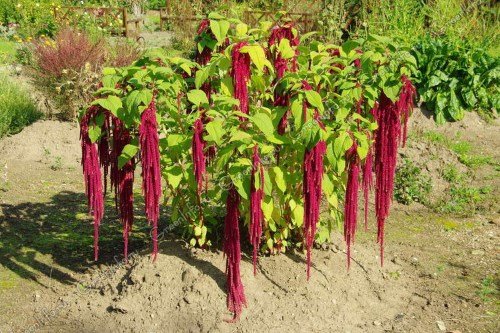

Plant in the garden
Contraindications
Biologically active elements found in amaranth are in concentrated form, especially high concentration in oil and in extracts from amaranth.
This is a potent drug and drug use is not recommended for people with:
- With cholelithiasis, acute cholecystitis, as it can provoke the movement of stones along the bile ducts and block them, which is life-threatening;
- With acute disease of the pancreas, acute pancreatitis;
- During the period of exacerbation of diseases of the gastrointestinal tract;
- People with an allergic reaction to amaranth.
